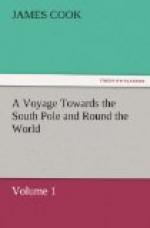On the east side of the north point of the island, (as Mr Gilbert, whom I sent to survey the parts, informed me) is a very snug harbour, of one mile or more in extent, wherein is seven, eight, and ten fathoms water, with a clean sandy bottom. The channel, by which he went in and out, lies close to the point, and has only three fathoms water; but he believes, that farther to the N.E. is a channel with a much greater depth, which he had not time to examine. Indeed, it would have taken up far more time than I could spare to have surveyed these parts minutely; as there lies a number of small islets and reefs of rocks along the N.E. side of the island, which seemed to extend to the N.E. farther than the eye could reach. The island of Amsterdam, or Tongatabu, is wholly laid out in plantations, in which are planted some of the richest productions of nature, such as bread-fruit, cocoa-nut trees, plantains, bananoes, shaddocks, yams, and some other roots, sugar-cane, and a fruit like a nectarine, called by them Fighegea, and at Otaheite Ahuya: In short, here are most of the articles which the Society Islands produce, besides some which they have not. Mr Forster tells me, that he not only found the same plants here that are at Otaheite and the neighbouring isles, but several others which are not to be met with there. And I probably have added to their stock of vegetables, by leaving with them an assortment of garden seeds, pulse, &c. Bread-fruit here, as well as at all the other isles, was not in season; nor was this the time for roots and shaddocks. We got the latter only at Middleburg.
The produce and cultivation of this isle is the same as at Amsterdam; with this difference, that a part only of the former is cultivated, whereas the whole of the latter is. The lanes or roads necessary for travelling, are laid out in so judicious a manner, as to open a free and easy communication from one part of the island to the other. Here are no towns or villages; most of the houses are built in the plantations, with no other order than what conveniency requires; they are neatly constructed, but do not exceed those in the other isles. The materials of which they are built are the same; and some little variation in the disposition of the framing, is all the difference in their construction. The floor is a little raised, and covered with thick strong mats; the same sort of matting serves to inclose them on the windward side, the other being open. They have little areas before the most of them, which are generally planted round with trees, or shrubs of ornament, whose fragrancy perfumes the very air in which they breathe. Their household furniture consists of a few wooden platters, cocoa-nut shells, and some neat wooden pillows shaped like four-footed stools or forms. Their common clothing, with the addition of a mat, serves them for bedding. We got from them two or three earthen vessels, which were all we saw among them. One was in the shape of a bomb-shell, with two boles in it, opposite each other; the others were like pipkins, containing about five or six pints, and had been in use on the fire. I am of opinion they are the manufacture of some other isle; for, if they were of their own, we ought to have seen more of them. Nor am I to suppose they came from Tasman’s ships; the time is too long for brittle vessels like these to be preserved.




